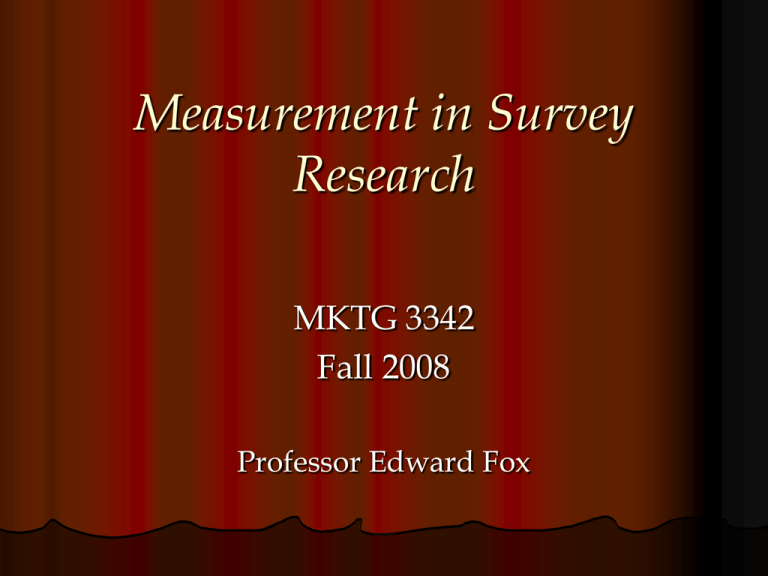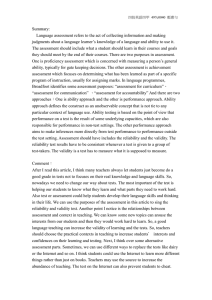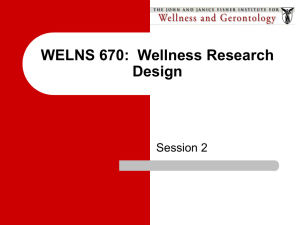Measurement in Survey Research MKTG 3342 Fall 2008
advertisement

Measurement in Survey Research MKTG 3342 Fall 2008 Professor Edward Fox Measurement in Survey Research Measurement is the process of assigning numbers or labels to the attributes of objects, persons, states, or events in accordance with specific rules The Measurement Process Research findings …which leads to… Utilize the scale If the evaluation is satisfactory, the researcher… Evaluate the reliability and validity of the scale …that requires the researcher to… Develop a construct Identify the concept of interest …which is used to… A measurement scale …which enables a researcher to create… …which is used to create… A constitutive definition An operational definition …which enables a researcher to develop … Steps 1&2: Identify Concept / Develop Construct Research findings Utilize the scale Evaluate the reliability and validity of the scale Develop a construct Identify the concept of interest A measurement scale A constitutive definition An operational definition Steps 1&2: Identify Concept / Develop Construct Measurement begins by identifying a concept of interest and the construct to be studied. Both are abstractions of reality. A concept is expressed in every-day terminology. This requires the researcher to generalize/categorize. A construct is a theoretical abstraction that can’t really be observed (e.g., love, trust, social class, personality, power). Steps 1&2: Identify Concept / Develop Construct – Example Question – Why do some customers buy Air Jordan athletic shoes over and over again? Concept – Repeat purchase Construct – Brand loyalty Steps 3&4: Define the Concept Conceptually and Operationally Research findings Utilize the scale Evaluate the reliability and validity of the scale Develop a construct Identify the concept of interest A measurement scale A constitutive definition An operational definition Steps 3&4: Define the Concept Conceptually and Operationally Constitutive Definition A theoretical or conceptual definition that defines the concept in terms of other concepts and constructs; like a dictionary definition Operational Definition Defines which observable characteristics will be measured and the process for assigning a value to the concept Steps 3&4: Define the Concept Conceptually and Operationally – Example Constitutive Definition – Increased propensity to purchase a brand due to previous experience with that brand Operational Definition – Rating of purchase probability, depending upon prior purchase Step 5: Develop a Measurement Scale Research findings Utilize the scale Evaluate the reliability and validity of the scale Develop a construct Identify the concept of interest A measurement Scale A constitutive definition An operational definition Step 5: Develop a Measurement Scale SCALE A scale is a set of symbols or numbers so constructed that the symbols or numbers can be assigned by a rule for the individuals (or their behaviors or attitudes) to whom the scale is applied Types of Scales Nominal Description Uses numerals to identify objects, individuals, events, or groups. Used for Classification (male/female; buyer/nonbuyer) Typical Descriptive Statistics Frequency Examples counts, percentages/modes of Nominal Scales Gender Geographic Area (1) Male (1) Urban (3) Suburban (2) Female (2) Rural Types of Scales Ordinal Scale Description In addition to identification, the numerals provide information about the relative amount of some characteristic; determines greater or less than Typical Descriptive Statistics Median Example of Ordinal Scale: Please rank the following fax machines from 1 to 5 with 1 being the most preferred and 5 the least preferred. _____ Panasonic _____ Toshiba _____ Sharp _____ Savin _____ Ricoh Types of Scales Interval Description Has all the properties of nominal and ordinal scales + equal intervals between consecutive points; preferred measure for complex concepts or constructs Typical Descriptive Statistics Mean/variance Example Scaled of an Interval Scale response (on a scale from 1 to 10…) Types of Scales Ratio Description Incorporates all the properties of nominal, ordinal, and interval scales plus it includes an absolute zero point Typical Descriptive Statistics Mean/variance Example Age, + a few higher order statistics of a Ratio Scale weight, height, population of the U.S., etc. Step 5: Develop a Measurement Scale – Example Probability of purchasing the shoe brand again in the next month, next year, or at any point in the future Type of scale? Step 6: Scale Reliability and Validity Research findings Utilize the scale Evaluate the reliability and validity of the scale Develop a construct Identify the concept of interest A measurement scale A constitutive definition An operational definition Step 6: Scale Reliability and Validity Any measurement can be expressed as a function of three components: XO = XT + XS + XR Observed Score = True Score + Systematic Error + Random Error Ideally, In Practice, XO = XT XO XT … that is, XS + XR 0 Total Error = XS + XR, where XS = Systematic error (validity) XR = Random error (reliability) Step 6: Scale Reliability and Validity – Illustration Not Reliable . . . . . . Not Valid . . . . ....... .. ...... . . . Reliable and Valid Scale Reliability The degree to which measures are free from random “noise” and, therefore, provide consistent data Issues Test-Retest Reliability Internal Reliability (split-half technique) Scale Validity Addresses the issue of whether what we attempted to measure was actually measured Issues Face Validity Content Validity Predictive Validity Convergent Validity Discriminant Validity Summary Measurement means using rules to assign numbers to objects in such a way as to represent quantities of attributes The measurement process is as follows: identify the concept of interest, develop a construct, define the concept constitutively and operationally, develop a measurement scale, evaluate the reliability and validity of the scale, and then use the scale There are four basic types of measurement scales: nominal, ordinal, interval, and ratio Summary (Cont.) Measurement data consists of information (“signal”) and error (“noise”). Validity requires that you actually measure what you intended to measure Reliability is the degree to which measures are free from random error



